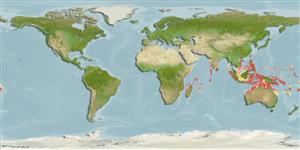Actinopterygii (ray-finned fishes) >
Perciformes (Perch-likes) >
Serranidae (Sea basses: groupers and fairy basslets) > Anthiinae
Etymology: Pseudanthias: Greek, pseudes = false + Greek, anthias = a fish, Sparus aurata (Ref. 45335).
Environment / Climate / Range
Ecology
Marine; reef-associated; depth range 2 - 40 m (Ref. 90102), usually 10 - 35 m (Ref. 27115). Tropical; 22°C - 28°C (Ref. 27115), preferred ?; 19°N - 24°S
Indo-West Pacific: Mauritius to the Philippines and Bali (Indonesia) to the Solomon Islands, south to Rowley Shoals and the Great Barrier Reef; Palau in Micronesia. Reported from southern Japan (Ref. 9710).
Size / Weight / Age
Maturity: Lm ? range ? - ? cm
Max length : 12.0 cm TL male/unsexed; (Ref. 2334)
Found primarily on continental reefs (Ref. 9710). Form aggregations on outer reef slopes to depths over 30 m (Ref. 9710). Feeds on planktonic crustaceans and fish eggs (Ref. 9710).
Life cycle and mating behavior
Maturity | Reproduction | Spawning | Eggs | Fecundity | Larvae
Randall, J.E., G.R. Allen and R.C. Steene, 1990. Fishes of the Great Barrier Reef and Coral Sea. University of Hawaii Press, Honolulu, Hawaii. 506 p. (Ref. 2334)
IUCN Red List Status (Ref. 115185)
CITES (Ref. 94142)
Not Evaluated
Threat to humans
Harmless
Human uses
Aquarium: commercial
More information
Common namesSynonymsMetabolismPredatorsEcotoxicologyReproductionMaturitySpawningFecundityEggsEgg development
ReferencesAquacultureAquaculture profileStrainsGeneticsAllele frequenciesHeritabilityDiseasesProcessingMass conversion
Tools
Special reports
Download XML
Internet sources
